Other pigmentary disorders of the skin
NOT every white spot is VITILIGO!
In our article, we have prepared for you a summary of the most similar pigment
disorders of the skin, which may appear as Vitiligo at first sight, but it is a completely different skin disease.
1. PITYRIASIS VERSICOLOR ALBA - or also tinea versicolor
This disease is most often confused with vitiligo!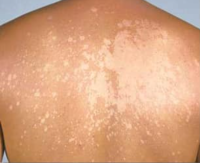 PITYRIASIS VERSICOLOR is a common, frequent disease caused by the skin yeast called Malassezia furfur.
PITYRIASIS VERSICOLOR is a common, frequent disease caused by the skin yeast called Malassezia furfur.
Yeast normally lives on the surface of healthy skin and feeds on sebum. Round or oval spots in size from about 0.5 to 2 cm are in a lighter shade than the skin. They can appear anywhere on the body, but their typical location is places with increased sweat production (back, shoulders, trunk or neck). The spots can be dry and scaly and itchy. They often appear after being in the sun, because the visibility of the affected areas increases after sunbathing. Creams, solutions or shampoos are used for treatment. Loss of pigment is visible several weeks to months after healing. Unfortunately, the infection often recurs, especially in warm and humid conditions.
2. PIEBALDISM 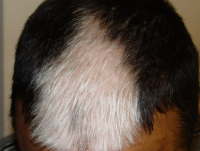
It is a rare congenital and hereditary disease that affects 0.001% of the population. A typical sign of piebaldism is a non-pigmented or white spot on the skin or a streak of hair already present at birth, but sometimes the abdomen, chest and both legs are also affected. The spots usually do not change during life, but minor repigmentation is possible. It is not an autoimmune disease like vitiligo, i.e. may not be associated with other autoimmune disorders. The eyes are not affected as in albinism. Piebaldism can be caused by genetic mutations that affect melanin production.
3. NEVUS DEPIGMENTOSUS
This "birthmark" is another of the disorders causing usually light and only exceptionally white spots on the skin or in the hair and pubic hair. It does not change with age, it just grows with its wearer. Unlike segmental 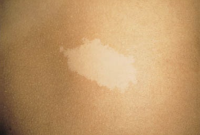 vitiligo, which is also stable but usually does not appear immediately at birth or in infancy, it sometimes has more jagged/ragged edges. If the spot is light (not white) and does not change in size, it may be NEVUS DEPIGMENTOSUS, basically a birthmark, which is lighter skin that appears in the first months of life. In addition, the nevus has sharper edges. With a little experience, the doctor can also recognize it by sight. On the other hand, the VITILIGO spot changes in size (grows over time) and is white (not just lighter pigmented). With vitiligo, new spots usually appear over time.
vitiligo, which is also stable but usually does not appear immediately at birth or in infancy, it sometimes has more jagged/ragged edges. If the spot is light (not white) and does not change in size, it may be NEVUS DEPIGMENTOSUS, basically a birthmark, which is lighter skin that appears in the first months of life. In addition, the nevus has sharper edges. With a little experience, the doctor can also recognize it by sight. On the other hand, the VITILIGO spot changes in size (grows over time) and is white (not just lighter pigmented). With vitiligo, new spots usually appear over time.
4. ALBINISM  The essence of albinism is the congenital absence of the enzyme tyrosinase, which is necessary for the production of melanin. Its formation does not occur in albinotic individuals, which is manifested by the coloring of parts of the body for which melanin is responsible. Colorless skin and often red-colored eyes are characteristic (the coloration is caused by blood showing through the capillaries). The skin is very sensitive to UV radiation and at the same time there is a higher risk of developing skin tumors. There is also a faster aging of the skin. The disorder can occur in humans, animals and plants.
The essence of albinism is the congenital absence of the enzyme tyrosinase, which is necessary for the production of melanin. Its formation does not occur in albinotic individuals, which is manifested by the coloring of parts of the body for which melanin is responsible. Colorless skin and often red-colored eyes are characteristic (the coloration is caused by blood showing through the capillaries). The skin is very sensitive to UV radiation and at the same time there is a higher risk of developing skin tumors. There is also a faster aging of the skin. The disorder can occur in humans, animals and plants.
5. HALO NEVUS 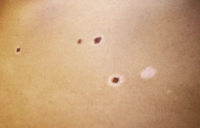 Halo nevus (marks with a halo) are usually harmless and typical of people with vitiligo as one of its manifestations. Our immune system is likely to evaluate some signs as a threat and start attacking them. At the same time, it also eliminates pigment cells. One of the possible reasons is a strong previous tan or burn. Another possibility is vitiligo, which in itself is an exaggerated reaction of the body. An immune attack on birthmarks often completely lightens them, turning them from dark to pink. Sometimes it even completely destroys them, making them disappear. However, memory T-lymphocytes continue to guard there (as if the body remembers a viral infection), so the pigmentation may not be restored and the white spot may remain (not 100%). Especially in children, everything can become pigmented over time. They are more common in people with vitiligo. Sometimes they also appear with malignant melanoma (in that case, birthmarks must be monitored!) or Turner syndrome. They are sometimes called Sutton´s nevus. They occur in approximately 1% of the population.
Halo nevus (marks with a halo) are usually harmless and typical of people with vitiligo as one of its manifestations. Our immune system is likely to evaluate some signs as a threat and start attacking them. At the same time, it also eliminates pigment cells. One of the possible reasons is a strong previous tan or burn. Another possibility is vitiligo, which in itself is an exaggerated reaction of the body. An immune attack on birthmarks often completely lightens them, turning them from dark to pink. Sometimes it even completely destroys them, making them disappear. However, memory T-lymphocytes continue to guard there (as if the body remembers a viral infection), so the pigmentation may not be restored and the white spot may remain (not 100%). Especially in children, everything can become pigmented over time. They are more common in people with vitiligo. Sometimes they also appear with malignant melanoma (in that case, birthmarks must be monitored!) or Turner syndrome. They are sometimes called Sutton´s nevus. They occur in approximately 1% of the population.
6. NEVUS ANEMICUS 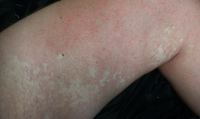
It is a congenital disorder characterized by spots of various sizes and shapes that are paler than the surrounding skin and do not turn red under pressure, cold or heat. The paler area is caused by blood vessels in the area. It is not a pigmentation disorder. It is especially noticeable when you get sunburned. This benign disorder appears on the skin at birth or in early childhood. In most people, they are smaller than 10 centimeters. Rubbing the spot will cause the skin around the spot to redden, while the spot itself will not change color. The spots are often difficult to see against the background of the skin color, but if a person burns, then the light area will stand out significantly. The affected area is lighter than normal skin, not because of a loss of pigment, but because the blood vessels are constricted, causing a permanent pallor the area.
Wood's lamp examination may also reveal that a nevus anemicus patch does not glow as brightly as a vitiligo patch.
7. WAARDENBURG SYNDROME 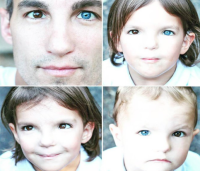
Waardenburg is a group of rare genetic disorders characterized by at least some degree of congenital hearing loss and pigmentation. However, it is a relatively rare disorder, affecting approximately one in 42,000 people. There are four types of the disease that differ depending on which genes are mutated. The most serious is IV. type because it affects the digestive system and may require surgery. The manifestations of the syndrome are lifelong, but do not directly affect life expectancy.
8. GENETIC MOSAICISM
Mosaicism refers to the occurrence of a genetic mutation in one of the cells of a developing human embryo. A mosaic is formed: some cells are healthy, others are not. However, all cells derived from the mutated cell will also carry the mutation. The earlier in embryonic development a mutation occurs, the more cells in the body will be affected.
If the skin and the so-called BLASCHKO'S LINES are affected, it is called PIGMENTARY MOSAICISM (pigment mosaic). It must be distinguished from the so-called HYPOMELANOSIS ITO, which affects more places. Neurological problems, convulsions, intellectual problems, scoliosis, weakness, etc. need to be checked. If these problems are not present, it is only a matter of skin color. And the problem remains forever.
9. HYPOMELANOSIS 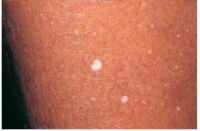
IDIOPATHIC GUTTATE HYPOMELANOSIS, i.e. "LIGHT DROPS OF UNKNOWN ORIGIN" up to 5 mm in size, usually affecting areas exposed to the sun. They appear more often (or earlier) in women, mostly in those who tan more. They may not always
be 100% depigmented as in vitiligo, but sometimes they are, thus resembling vitiligo. In that case, they will also appear under Wood´s lamp. The origin is unclear, but they could be related to the destruction of melanocytes in the sun, repeated microtraumas (shaving) or aging of the skin.
10. LICHEN STRIATUS 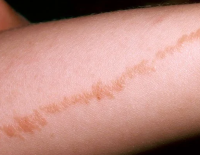 Lichen striatus (LY kuhn stry AY tuhs) is a rare skin rash that occurs mainly in children. It starts as pink spots or eczema that coalesce into one or more dull red, slightly scaly linear stripes, usually on the hands and feet. They may itch. After some time, the redness may subside and light spots remain. The cause of lichen striatus is unknown. Genetic factors or environmental triggers may play a role in its development. It occurs apparently along the so-called Blaschko's lines, which are apparently of embryonic origin. More than 50% of cases occur in children between the ages of 5 and 15. It occurs two to three times more often in women than in men. It is rare in adults. It is sometimes called blaschkoid dermatitis or blaschkitis.
Lichen striatus (LY kuhn stry AY tuhs) is a rare skin rash that occurs mainly in children. It starts as pink spots or eczema that coalesce into one or more dull red, slightly scaly linear stripes, usually on the hands and feet. They may itch. After some time, the redness may subside and light spots remain. The cause of lichen striatus is unknown. Genetic factors or environmental triggers may play a role in its development. It occurs apparently along the so-called Blaschko's lines, which are apparently of embryonic origin. More than 50% of cases occur in children between the ages of 5 and 15. It occurs two to three times more often in women than in men. It is rare in adults. It is sometimes called blaschkoid dermatitis or blaschkitis.
The basis of effective treatment of a skin disease is its correct diagnosis.
Many of the mentioned skin diseases can be confused. So if you are not sure about your diagnosis, do not hesitate to consult a doctor. Only then proceed to treatment!
We are keeping our fingers crossed for the treatment of your skin disease
Your Vitiligoshop
.jpg)